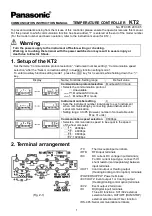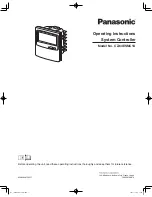
M60 MOTOR PROTECTION SYSTEM – INSTRUCTION MANUAL
2-1
M60 Motor Protection System
Chapter 2: Product description
Product description
This chapter outlines the product, order codes, and specifications.
2.1 Product description
The M60 Motor Protection System is part of the Universal Relay (UR) series of products. It is a microprocessor-based relay
for the protection and management of medium and large motors.
Overvoltage and undervoltage protection, thermal overload, fault diagnostics, and remote terminal unit (RTU) functions are
provided. The M60 provides phase, neutral, ground and negative sequence, instantaneous and time overcurrent
protection. The time overcurrent function provides multiple curve shapes or FlexCurve™ for optimum co-ordination.
The relay also features an enhanced thermal model with custom curves, current unbalance biasing, and running and
stopped exponential cooling curves. An optional resistance temperature detector (RTD) module allows for the thermal
model RTD bias function. Motor start and supervision functions include starts per hour, time between starts, restart time,
acceleration time, emergency restart, and start inhibit. Sensitive directional power, mechanical jam, and current
unbalance elements are included as standard functions. Additional functions that are not part of the standard M60
element set can be easily configured and implemented using the FlexElement™ and FlexLogic™ functionality.
Voltage, current, and power metering are built into the relay as standard features. Current parameters are available as
total waveform root mean square (RMS) magnitude, or as fundamental frequency only RMS magnitude and angle (phasor).
Diagnostic features include an event recorder capable of storing 1024 time-tagged events, oscillography capable of
storing up to 64 records with programmable trigger, content, and sampling rate, and data logger acquisition of up to 16
channels, with programmable content and sampling rate. The internal clock used for time-tagging can be synchronized
with an IRIG-B signal, using the Simple Network Time Protocol (SNTP) over the Ethernet port, or using the Precision Time
Protocol (PTP). This precise time stamping allows the sequence of events to be determined throughout the system. Events
can also be programmed (via FlexLogic equations) to trigger oscillography data capture that can be set to record the
measured parameters before and after the event for viewing on a computer. These tools significantly reduce
troubleshooting time and simplify report generation in the event of a system fault.
Several options are available for communication. An RS232 port (USB port with the graphical front panel) can be used to
connect to a computer for the programming of settings and the monitoring of actual values. The rear RS485 port allows
independent access by operating and engineering staff. It can be connected to system computers with baud rates up to
115.2 kbps. All serial ports use the Modbus RTU protocol. The IEC 60870-5-103 protocol is supported on the RS485
interface. IEC 60870-5-103, DNP, and Modbus cannot be enabled simultaneously on this interface. Also only one of the
DNP, IEC 60870-5-103, and IEC 60870-5-104 protocols can be enabled at any time on the relay. When the IEC 60870-5-103
protocol is chosen, the RS485 port has a fixed even parity and the baud rate can be either 9.6 kbps or 19.2 kbps. The
100Base-FX or 100Base-TX Ethernet interface provides fast, reliable communications in noisy environments. The Ethernet
Summary of Contents for M60
Page 9: ...TABLE OF CONTENTS M60 MOTOR PROTECTION SYSTEM INSTRUCTION MANUAL ix INDEX ...
Page 10: ...x M60 MOTOR PROTECTION SYSTEM INSTRUCTION MANUAL TABLE OF CONTENTS ...
Page 552: ...5 344 M60 MOTOR PROTECTION SYSTEM INSTRUCTION MANUAL TESTING CHAPTER 5 SETTINGS 5 ...
Page 660: ...iv M60 MOTOR PROTECTION SYSTEM INSTRUCTION MANUAL ABBREVIATIONS ...
















































